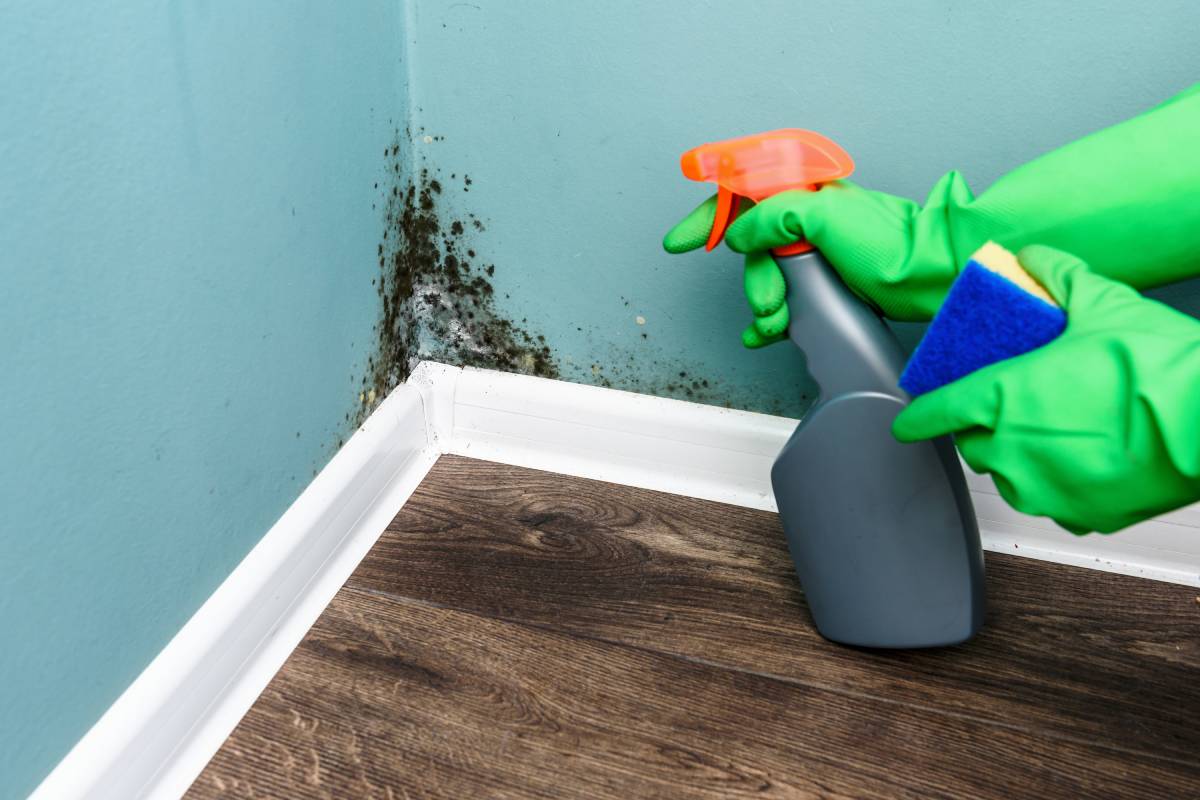How to Get Rid of Mould?
Dealing with Small Mould Problems
If dealing with a small mould colony (a few feet wide), consider cleaning it yourself:
- Identify the Surface: Determine if the mould is on a porous or non-porous surface. Non-porous surfaces include metal, rock, and tile, while porous ones, like drapes or wood, require more effort.
- Protect Yourself and Space: Wear an N95 respirator, close doors, and open windows to direct spores outside. Consider using an air purifier for added protection.
- Prepare Cleaning Products: Use soap and warm water instead of bleach to preserve air quality. Have two buckets for soapy water and rinsing.
- Scrub and Dry: Remove as much mould as possible, ensuring the cleaned area dries thoroughly. Dispose of porous objects if necessary.
- Monitor for Return: Check the area for several weeks to ensure mould doesn’t return. Replace items like carpet or repaint once the area stays mold-free.

Handling Larger Mold Problems
For larger colonies, consider professional help. But if you would like to do it yourself, make sure to:
- Assess Surfaces: Identify the extent of infestation, especially on porous surfaces, which may require removal.
- Protect Yourself: Wear a respirator and take precautions to prevent spores from spreading.
- Address Moisture First: Solve the moisture problem before cleaning to prevent mould recurrence. Use heat or a dehumidifier to ensure the area is dry.
- Scrub and Remove: Clean visible mould with warm soapy water. For wood, sand down to a non-mouldy layer. Replace soft materials like drywall.
- HEPA Vacuum: Use a HEPA vacuum to remove scattered mould spores. Wipe down areas where spores may have spread.
- Carpet Considerations: Carpets are often unrecoverable after mold infestation. Explore ways to salvage them, but replacement may be necessary.
- Thorough Drying: Ensure the cleaned area is completely dry. Use a hard brush, baking soda, vinegar, steam cleaner, and an anti-fungal coating for comprehensive mould removal.
- Structural Elements: If mould has deeply penetrated structural elements, consider hiring a professional mould remover.
Mould in Air Conditioners
Air conditioners can harbour mould. Prevent mould growth by tilting window-mounted units, minimising dust, and cleaning visible mould promptly. Here’s how you do it:
General Tips for Mold Cleanup: Cleaning mould can be challenging, so it’s important to choose the right method based on the type of air conditioner. Ensure good ventilation, wear non-porous gloves, and use a face mask with goggles, especially if you’re sensitive to mould. Mould on non-porous surfaces can be wiped with a household cleaner and cloth. For porous surfaces like wood or carpet, removal and replacement may be necessary.
Window Unit:
- Small mould spots on window AC units may indicate a larger issue.
- Disassemble the unit to clean internal components, but there’s a risk of missing some mould.
- If mould is extensive, replacement of the window AC unit might be necessary.
Central AC:
- Mould in central AC ductwork usually requires professional remediation.
- Shut off the system when mould is detected to prevent further spread.
- Cleaning ducts can be expensive and challenging, especially if mould has spread throughout the system.
- Sheet metal ducts are easier to clean than other materials.
- Avoid using biocides or surface treatments in ductwork, as recommended by the EPA.
Car AC:
- Under normal conditions, car AC systems should drain moisture properly.
- If the car gets wet, promptly clean and dry it, and replace the cabin air filter.
- Mould growth in the AC system is limited, but disassembling the dashboard for cleaning is an option.
- Moldy ducts can be replaced, but the effort and cost vary.
- Exercise caution with chemical products in the AC system, as their effectiveness is uncertain, and inhaled chemicals can pose risks.
Conclusion
When it comes to mould cleanup, it’s a good idea to consider not only the type of air conditioner but also your ability to handle the task effectively. While DIY methods can work for smaller mould issues, particularly with proper precautions, seeking professional help becomes crucial as the scale and complexity increase.
Moreover, for a comprehensive approach to maintaining a mould-free environment, integrating an air purifier can be beneficial. Air purifiers not only help eliminate airborne mould spores but also contribute to overall air quality. When facing uncertainties or dealing with extensive mould problems, considering alternatives like professional remediation or the assistance of advanced technologies ensures a thorough and efficient solution for a healthier living space.






